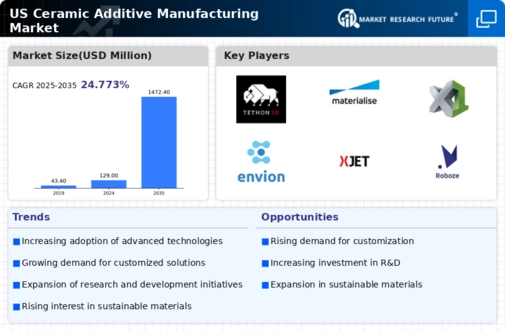The US Ceramic Additive Manufacturing Market is witnessing a significant transformation driven by advancements in technology and growing applications across various industries such as aerospace, automotive, healthcare, and art. The competitive landscape is characterized by the presence of innovative companies that are actively pushing the boundaries of material science, production techniques, and design capabilities. As the demand for high-precision manufacturing with ceramics rises, businesses are focusing on creating unique solutions that address specific market needs.
Companies in this sector are also exploring partnerships, patent acquisitions, and research initiatives to enhance their product offerings and establish a stronger foothold in this emerging market. Tethon 3D has emerged as a notable player in the US Ceramic Additive Manufacturing Market, focusing on demonstrating its strengths in developing high-performance ceramic materials and 3D printing technologies. The company's commitment to innovation is showcased through its proprietary materials designed specifically for additive manufacturing, which provide superior mechanical properties and intricate designs.
Tethon 3D’s ability to cater to niche applications in industries like dental, jewelry, and complex engineering components has bolstered its market presence. Moreover, their focus on collaboration with research institutions and manufacturers has established them as a trusted supplier of ceramic materials, enhancing their reputation and visibility in the US market. Materialise is another key competitor within the US Ceramic Additive Manufacturing Market, renowned for its comprehensive software solutions and expertise in 3D printing services.
The company offers an extensive range of products catering to various industries, including healthcare and consumer goods, with a significant portfolio dedicated to ceramic additive manufacturing. Materialise leverages its advanced software to facilitate seamless integration and optimization of the printing process, ensuring high-quality outputs. The company has built a solid market presence through strategic mergers and acquisitions that have enabled it to expand its capabilities and client base.
Strengths of Materialise lie in its rich history of innovation, customer-centric approach, and robust support services that allow it to maintain a competitive edge in the evolving landscape of ceramic additive manufacturing in the US.




















